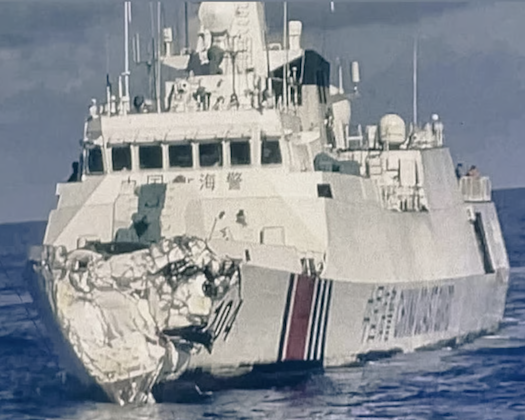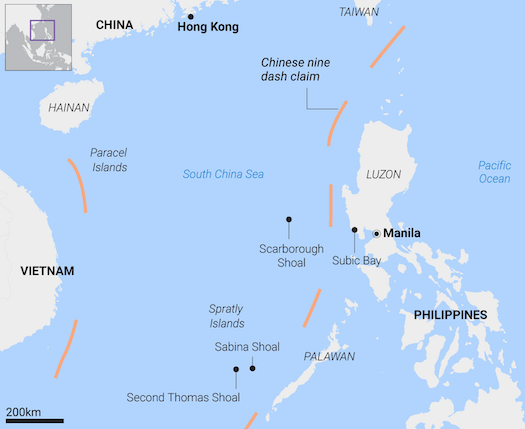
OOPS: Chinese Coast Guard Cutter Crashes Into Chinese Warship While Pursuing Philippine Vessel Near Scarborough Shoal

New York, N.Y. — Tensions Flare as Video Captures Dramatic Collision During Maritime Chase Near Disputed Scarborough Shoal; Damage Sustained but No Injuries Reported
A Routine Patrol Erupts into Maritime Chaos
What began as a tense but routine patrol near the disputed Scarborough Shoal on August 11, 2025, quickly escalated into a dramatic maritime incident that has reverberated across the region.

As the morning sun shimmered on the calm waters some 12 nautical miles (22km) from the reef, the Philippine Coast Guard cutter BRP Suluan buckled down to its mission: escort two small civilian relief boats laden with food, fuel, and vital supplies for local Filipino fishermen.
In this narrow waterway—claimed by both China and the Philippines—fishing rights have long been a flashpoint, and the deployment of official vessels signals not only national pride, but also geopolitical intent.
On this particular day, however, the already volatile theater of the South China Sea was about to witness a rare and almost surreal mishap.
A Chinese coast guard ship, hull number 3104, rapidly closed in on the Philippine cutter, arcing high-pressure water jets across Suluan’s bow in a menacing display of force.
From the port side, a monumental threat loomed: the People’s Liberation Army Navy destroyer Guilin, hull number 164. Suddenly, two ships of the same flag, in their haste and proximity to their quarry, found themselves on a collision course.
Video Footage Sparks International Outcry
Video released by the Philippine Coast Guard documents the sequence of events with chilling clarity.

As Suluan evades the jets, the Chinese cutter becomes so engrossed in its pursuit that it fails to anticipate the path of the larger Guilin.
There is a thunderous crash. Both Chinese vessels grind to a halt, one with severe damage to its forward deck, while the Filipino ship sails on, its humanitarian mission disrupted but its hull intact.
The footage, widely shared across global media platforms, has prompted both condemnation and incredulity.
In the aftermath, officials in Manila denounced the “hazardous maneuvers” and blamed China for reckless escalation, while Chinese spokespeople insisted that their law enforcement response was “professional and legitimate,” faulting the Philippine ships for intrusion and dangerous navigation.
Notably, although China admits a confrontation took place, its official statements omit any direct reference to the embarrassing collision itself.
The Broader South China Sea Dispute
The Scarborough Shoal, known in Chinese as Huangyan Island, is a triangular cluster of rocks and reefs that has lain at the heart of the regional territorial dispute since China seized control after a 2012 standoff. The Shoal is just 137 miles (220km) from Luzon, the largest island of the Philippines, but sits well within what China claims as its “nine-dash line,” a loosely defined, centuries-old demarcation encompassing nearly the entire South China Sea.
The resource-rich waters around Scarborough Shoal teem with vital fisheries and are considered strategically critical choke points for military and commercial shipping.
The Shoal is also an emotional touchstone for Filipino fishermen, many of whom have watched their traditional livelihoods diminish as Chinese patrols have used intimidation and at times outright force—including ramming of vessels and the use of water cannons—to push them away from these ancestral fishing grounds.
“Gray Zone” Tactics and Rapid Escalations
What makes this incident uniquely alarming is that it exposes the perils of what analysts describe as “gray zone” tactics: aggressive but non-lethal coercion just short of direct armed conflict. Both the Philippine and Chinese authorities know well the rules of the sea and the fine line between demonstration of presence and outright confrontation.
For years, Chinese vessels—coastguard, navy, and an expanding civilian maritime militia—have trailed, shadowed, and at times collided with Philippine and other foreign vessels in these waters, each episode incrementally escalating the standoff.
In this latest mishap, the lack of coordination between the Chinese cutters—both focused on boxing in the smaller Philippine craft—led not just to an embarrassment for Beijing, but also a sobering reminder of how quickly such confrontations can spin out of control.
Commodore Jay Tarriela of the Philippine Coast Guard called the event “highly risky and indicative of out-of-control brinkmanship.” Local news described the Chinese coast guard ship as “rendered unseaworthy,” though Chinese sources have minimized the nature and extent of the damage.
U.S. and International Reactions
Within 48 hours of the collision, the United States Navy deployed two warships—USS Higgins and Cincinnati—to international waters near the Scarborough Shoal, signaling both support for Manila and concern for navigational freedom in the region.
These “freedom of navigation” operations, regular features of U.S. strategy in the South China Sea, have, over the years, become almost routine—but during high-tension incidents such as this, they take on greater significance.
As Western and regional powers watch closely, any escalation risks drawing outside forces into what began as a bilateral confrontation.
Both Vietnam and Taiwan, which have overlapping claims in the South China Sea, voiced their own unease, urging all sides to exercise restraint and respect for international maritime law. Diplomatic backchannels between Washington, Beijing, and Manila were abuzz. The Association of Southeast Asian Nations (A.S.E.A.N.) called for “maximum restraint” and dialogue.
Aftermath: Blame, Diplomacy, and Lessons Unlearned
Both Beijing and Manila are trading diplomatic protests. China has demanded that the Philippines “cease provocative actions” and respect Chinese sovereignty over what it calls its “inherent territory.”
The Philippines, meanwhile, insists it was operating entirely within its own Exclusive Economic Zone, and that no amount of water cannon fire or intimidation will force it to cede traditional fishing grounds or bow to Beijing’s maritime might.
Neither side reported injuries from the incident, and the Philippine mission ultimately completed its humanitarian task. But maritime experts warn that the episode’s lessons are disturbing: in a sea crowded with national and commercial ships—and bristling with weapons from destroyers to less-than-lethal water cannons—even a small miscalculation or overzealous maneuver can flash into international crisis.
The Ongoing Risk of Maritime Confrontation
As further analysis of the video and satellite imagery emerges, many observers have faulted the communications—or lack thereof—between Chinese ships, underscoring the risk that even deeply disciplined navies can falter in high-pressure, high-stakes environments.
If friendly ships can collide pursuing a common adversary, analysts warn, what chance is there to prevent a tragic accident should adversaries lock horns in even closer quarters?
This incident at Scarborough Shoal thus stands as both a warning and a call for renewed de-escalation mechanisms between all claimants in the South China Sea. For the fishermen of Zambales and for the sailors on all sides, the return to normalcy remains uncertain.
Summary: Scarborough Shoal Flares as Chinese Ships Collide South China Sea
At Scarborough Shoal on August 11, 2025, two Chinese vessels—a navy destroyer and a coast guard ship—collided while pursuing a Philippine Coast Guard cutter supplying aid to local fishermen. Dramatic video showed the Chinese ships, focused on intercepting the Philippine vessel, crashing into each other. Damage to one Chinese ship was evident, but no injuries were reported. The incident has escalated tensions between Beijing and Manila, prompting international scrutiny and a renewed U.S. naval presence.